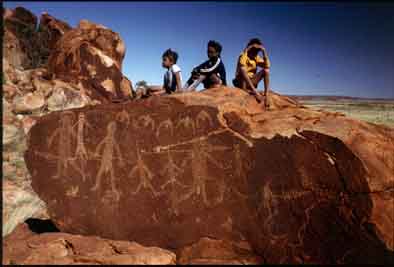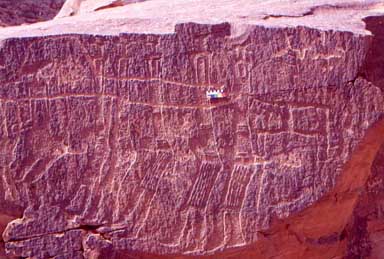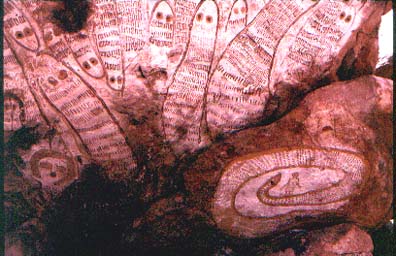AURANET
Welcome to the homepage of the Australian Rock Art Research Association, Inc.
AURA (the Australian Rock Art Research Association, Inc.) was founded in October 1983 and within five years became the world’s largest rock art organisation. AURA’s membership of rock art scholars is dedicated to the study and preservation of rock art in Australia and the world, and to the promotion of indigenous custodianship of traditional indigenous cultural heritage. AURA also promotes general awareness and appreciation of this heritage, in Australia and elsewhere, and high research standards in the field of palaeoart studies.
AURA is a founding member of the International Federation of Rock Art Organisations (IFRAO).
To open any of the pages of AURANET please click on one of the items in the above menu.

Aboriginal initiates at Pilbara petroglyph site

Neolithic petroglyphs at Umm-Sinman, Jubbah, Saudi Arabia

Pictograms of the mighty Rainbow Serpent (lower right) with some of her babies
View the Constitution of AURA
View the contents of Rock Art Research.
The second edition of the standard handbook of rock art studies, Rock art science: the scientific study of palaeoart is now available.
ROCK ART BOOKS from AURA
AURANET LIBRARY
The AURANET LIBRARY is located here. This study resource forms the main part of AURANET. Please browse, download and use. To cite, please quote the URL unless alternative bibliographical information is given on the relevant page.
The R. G. Bednarik Library is a substantial repository of refereed papers by the moderator of AURANET, and features hundreds of PDFs. Please visit and download.
AURANET is listed and referenced by the International Center for Scientific Research, the ISI Web of Knowledge, the Web of Science, Current Contents Connect and Current Web Contents of Thomson Scientific.
The Rock Art Preservation Fund is a registered charity
How will the funds be used?
Funds are used exclusively in conducting public campaigns, educational programs and research into the causes and amelioration of rock art deterioration. They may also be used in the creation of educational material, and in representations to such international bodies as UNESCO, the World Heritage Office or the World Monuments Fund. None of the funds is used for administration or salaries, office expenses or any other incidental costs.
Key areas of expenditure
Holding free public exhibitions and conducting conferences.
- Facilitating reconciliation through the repatriation of cultural heritage under threat.
- Lobbying to influence politicians and major developers to avoid the destruction of traditional cultural heritage, particularly rock art and stone arrangements.
- Research into the deterioration of rock art and the development of methods of palliative intervention.